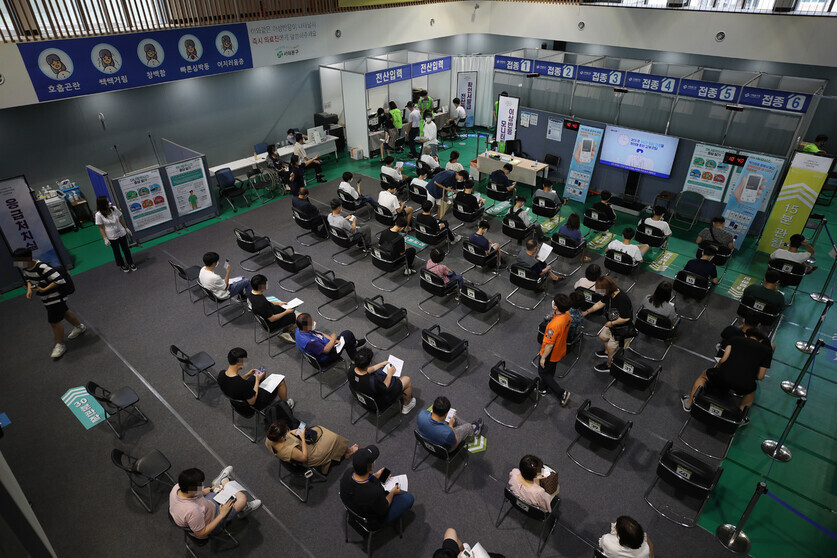hankyoreh
Links to other country sites 다른 나라 사이트 링크
Delta variant’s fatality rate remains unknown while caseload continues to rise

The Delta variant of the coronavirus, which is more transmissible than the original virus, is rapidly spreading through Korea during the fourth wave of the COVID-19 pandemic. That raises the question of whether the variant is more likely to cause serious or fatal cases of COVID-19.
South Korea’s Central Disease Control Headquarters (CDCH) said Tuesday that 1,233 (54.8%) of 2,249 domestic COVID-19 patients who underwent genomic testing over the past week (July 18-24) were infected with one of the major virus variants. Significantly, 1,080 (48%) of those 2,249 patients were infected with Delta.
“Delta has now become the dominant strain in Korea, too,” said Lee Sang-won, director of the CDCH’s epidemiological research analysis team, in the daily briefing on Tuesday.
The percentage of cases that become serious and the percentage that end in death, known as the case fatality rate, have both fallen steadily since Korea began administering COVID-19 vaccines to the older adults, who represent the high-risk group in the pandemic, on Feb. 26. In January, 3.15% of cases were serious and 1.42% ended in death. But by June, those rates had fallen to 2.22% and 0.24%, respectively.
Though Delta has now become the dominant variant, it remains unclear what impact it has on the case fatality rate.
“It’s believed that [Delta’s] hospitalization rate is 120% higher than that of Alpha, but there haven’t been any definitive research findings about the case fatality rate yet. So far, we don’t have any grounds for concluding that Delta is deadlier,” Lee said.
It takes around a month after infection for a COVID-19 case to become serious and lead to death. That means that the human toll of the fourth wave of COVID-19, when the Delta variant started to have an impact, probably won’t become apparent until mid-August.
By that time, a considerable number of people in their 50s will have received their first dose of the COVID-19 vaccine.
A number of experts on the response to COVID-19 are calling for a fresh discussion about how to manage the relationship between disease control measures such as social distancing and routine activities such as the livelihood of small business owners.
“During the third wave of COVID-19, we had [COVID-19 patients] in as many as 50 beds in the ICU after outbreaks in nursing homes. But currently, only 12 beds are occupied, and only five of those patients have COVID-19,” said Kim Nam-jung, a professor of infectious disease at Seoul National University.
“Given the current mood in society, we won’t be able to fully open up schools in the fall semester, which will cause damage to various parts of society, including the economy and the educational sector. It’s time to discuss ways to minimize that harm,” Kim said.
“COVID-19 infections among young people [who account for most cases in the fourth wave] have a low risk of becoming serious and have less of an impact on society. Since we have a long war to wage with this highly infectious coronavirus, focusing our efforts on protecting and treating high-risk groups, including the older adults, would be more strategic [than relying on across-the-board social distancing measures],” said Bang Ji-hwan, head of the central infectious disease hospital operations center at the National Medical Center.
By Seo Hye-mi, staff reporter
Please direct comments or questions to [english@hani.co.kr]

Editorial・opinion
![[Guest essay] Maybe Korea’s rapid population decline is an opportunity, not a crisis [Guest essay] Maybe Korea’s rapid population decline is an opportunity, not a crisis](https://flexible.img.hani.co.kr/flexible/normal/500/300/imgdb/original/2024/0430/9417144634983596.jpg) [Guest essay] Maybe Korea’s rapid population decline is an opportunity, not a crisis
[Guest essay] Maybe Korea’s rapid population decline is an opportunity, not a crisis![[Column] Can Yoon steer diplomacy with Russia, China back on track? [Column] Can Yoon steer diplomacy with Russia, China back on track?](https://flexible.img.hani.co.kr/flexible/normal/500/300/imgdb/original/2024/0430/1617144616798244.jpg) [Column] Can Yoon steer diplomacy with Russia, China back on track?
[Column] Can Yoon steer diplomacy with Russia, China back on track?- [Column] Season 2 of special prosecutor probe may be coming to Korea soon
- [Column] Park Geun-hye déjà vu in Yoon Suk-yeol
- [Editorial] New weight of N. Korea’s nuclear threats makes dialogue all the more urgent
- [Guest essay] The real reason Korea’s new right wants to dub Rhee a founding father
- [Column] ‘Choson’: Is it time we start referring to N. Korea in its own terms?
- [Editorial] Japan’s rewriting of history with Korea has gone too far
- [Column] The president’s questionable capacity for dialogue
- [Column] Are chaebol firms just pizza pies for families to divvy up as they please?
Most viewed articles
- 1Months and months of overdue wages are pushing migrant workers in Korea into debt
- 2[Guest essay] Maybe Korea’s rapid population decline is an opportunity, not a crisis
- 3Dermatology, plastic surgery drove record medical tourism to Korea in 2023
- 4Under conservative chief, Korea’s TRC brands teenage wartime massacre victims as traitors
- 5First meeting between Yoon, Lee in 2 years ends without compromise or agreement
- 6[Column] Can Yoon steer diplomacy with Russia, China back on track?
- 7[Editorial] Japan’s rewriting of history with Korea has gone too far
- 8[Editorial] When the choice is kids or career, Korea will never overcome birth rate woes
- 9[Column] Why Korea’s hard right is fated to lose
- 10Korean research team finds potential link between nanoplastics, obesity